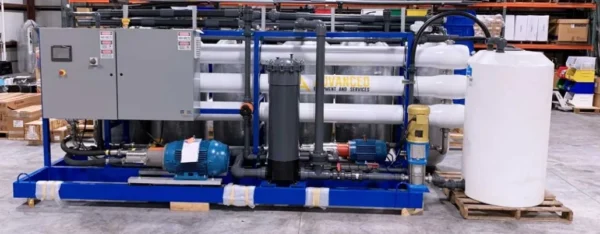
Water Efficiency in Agriculture: Using Industrial RO Membranes for Irrigation

Water in coastal and marshy regions is often brackish, which is to say, it has salt content, but not as much as seawater. Partially filtered through delta beds, sand, grit, and soil, brackish water is still not potable (drinkable), nor is it suitable for use in agriculture. However, people around the world are beginning to benefit from this resource of inland, brackish water, through industrial reverse osmosis systems that can remove up to 99% of dissolved solids, including salt, making the water usable for irrigation, and opening up a whole new water supply for your farmland. Industrial reverse osmosis arrays can open up agricultural access to water that was previously inaccessible, because of high sodium content, or other contaminant levels.
Overview of Water Efficiency in Agriculture
To be water-efficient, you need to use the water that is available, and if you have access to brackish water, or water that is otherwise suspect for use in irrigation, then one of the best ways to address this problem is through the application of industrial reverse osmosis filtration. This article will focus on brackish water conditions, as these are ideal for RO treatment. However, there are a wide variety of industrial RO membranes designed for specific use cases, including desalination, energy-saving, anti-fouling and sewage treatment, and so forth. Furthermore, these RO membranes can (and usually should) be used as one step in a multi-stage water treatment process designed to prolong the life of the membrane array.
The Challenge of Water Usage in Agriculture
Farmers face many challenges when it comes to water: ensuring that there is sufficient water for their crops, that their distribution systems are in working order, and that the water is relatively free of contaminants that would harm their yield. Depending on the source of your water, you may be dealing with chlorine and/or chloramines, disinfectant by-products, PFAS, microplastics, volatile organic compounds, and heavy metals. Many of these contaminants have hugely deleterious effects on crops, and should be removed. This brings with it difficulties and costs, but it’s worth it in the long run for the benefit to your crops, and the health of everyone who eats them.
What are Industrial RO Membranes?
Initially developed in the 1960s to remove salt from seawater, reverse osmosis membranes use polyamide barriers with pore sizes as small as 0.0001 microns. For comparison, a human hair is around 70 microns thick. The pores of a polyamide sheet in a reverse osmosis system are so small that they cannot be seen, even with the aid of an electron microscope. They allow almost nothing but pure water molecules to pass through, constraining nearly everything else. This function makes them very adept at removing dissolved sodium chloride, or regular salt, and they are commonly used in coastal desalination plants, yachts, and cruise ships, for the production of potable water. The designation “industrial” sets these larger membranes apart from smaller, residential membranes for under sink use.
Industrial reverse osmosis membranes are used in all sorts of industries, from desalination plants, to food and beverage manufacturing plants, for water boiler pre-treatment, use in electronics fabrications, and many more. Many high-end restaurants and coffee shops use large industrial RO systems in-house to ensure the highest quality.
How RO Membranes Improve Water Efficiency in Irrigation
The benefit of RO is not in direct efficiency improvement per se, as RO is a costly process, requiring a great deal of electricity to power water through the microscopic pores. When many membranes are running simultaneously, the juice adds up. Where an industrial RO setup can improve a farmer’s opportunities is in giving them access to brackish or otherwise unusable water in their area. These systems present a way to get at problematic water in your area that would otherwise be totally unsuitable for agricultural use. Heavy-duty anti-fouling membranes can even handle industrial sludge and waste, so there are options for water of nearly any quality.
Benefits of Industrial RO Membranes for Agriculture
Producing RO water is costly and time-consuming, but it opens up a swath of water that was previously inaccessible, and it produces great water that is excellent for crops. Fewer contaminants in the water means better crop and soil health. Heavy metals, salt, and other contaminants in water can stay in soil for a very long time, and continual accumulation can lead to serious problems. Switching to RO-treated water avoids this eventuality, and ensures your plants get only what they need. Reverse osmosis membranes are capable of reducing TDS to a miniscule fraction, taking out heavy metals, cysts, parasites, nanoplastic particles, PFAS, and a whole host of other dangerous contaminants.
Challenges and Considerations
The big drawbacks of utilizing RO at a large scale are two-fold: 1) the power needed to generate sufficient pressure to pump water through the industrial membranes, and 2) the amount of waste-water produced. The power needed will vary based on the size of your operation and RO array, but generally the pressure requirements for these systems is quite high. Waste-water is an issue that has to be dealt with in any reverse osmosis application, as it is a fundamental feature of that technology. If you need a solution that does not produce waste water, you might consider nanofiltration or ultrafiltration. These are also “membrane-style” filters, though they are not as aggressive as reverse osmosis membranes. They do not produce waste-water, at the cost of larger pore sizes, and less robust filtration.
Conclusion
Reverse osmosis technology opens up a lot of possibilities, making even seawater potable and safe for human consumption and agricultural use. For many farmers, treating brackish water in their area with an industrial reverse osmosis membrane array is a sensible way to access water near to hand that was previously unusable. The initial costs may be steep, but it will pay big dividends down the line.














































